Thermometer and hygrometer calibration

Main content
- Thermo-hygrometer
- Classification of Thermo-hygrometer
- Structure and operating principle
- Application
- Why should you calibrate a Thermo-hygrometer?
- Thermo-hygrometer - calibration procedure
Temperature and humidity are two quantities that have a close relationship and interact with each other. Air humidity is influenced by environmental temperature. When the temperature increases, the evaporation rate of water becomes faster and the humidity in the air will decrease.
A thermo-hygrometer is a device used to monitor the temperature and humidity of the surrounding environment at a time, a combination of a thermometer and a hygrometer or hygrometer. It is used in an area or room where temperature and humidity are important in a process like in laboratories, manufacturing areas, pharmaceuticals, food industries, etc. This is an important tool to detect and evaluate the impact of environmental factors on products or production processes, thereby providing solutions to prevent and control the environment and limit risks affecting machines. machinery, equipment, raw materials, and finished product quality.
2. Classification of Thermo-hygrometers
Currently, thermo-hygrometers are widely used and popular in all areas of life. Thermometers can be classified into the following basic groups:
- Mechanical hygrometer: Measure temperature and humidity using a spring. Depending on the temperature and humidity, the spring will expand or contract, thereby indicating the humidity value.
- Electronic thermometer and hygrometer: Uses an electric sensor instead of a spring, like a mechanical thermometer and hygrometer. The resistance of this sensor is affected by humidity, which will display the humidity value at present.
3. Structure and operating principle
A thermo-hygrometer has an uncomplicated structure, including 2 main parts:
• Wireless transceiver placed outdoors helps determine outdoor humidity and temperature.
• LCD screen is used to measure indoor temperature and humidity. In addition, this part also displays the humidity and outdoor temperature transmitted by the transceiver.
This type of thermo-hygrometer operates based on modern digital sensor technology, therefore it has high sensitivity and accuracy. Thermal sensors are capable of recording changes in temperature and humidity from the surrounding environment, even the smallest changes. That data is then transmitted to the receiver, which is an indoor LCD screen that displays all parameters in percentage form.
4. Application
- Indoor: A thermo-hygrometer is used to monitor the temperature and humidity in the house, thereby making appropriate adjustments for air conditioners, dehumidifiers, humidifiers, mist sprayers, etc. to improve air quality. air in the room, ensuring human health. The device helps users be proactive in taking care of themselves and their family's health.
- Industry: Check the humidity of materials such as plastic beads, and wood... or check the humidity in the storage room. There are many different methods of measuring humidity, with varying accuracy depending on certain requirements and purposes.
- Agricultural industry: Check the moisture of seeds, check the moisture of agricultural products, or use in agricultural storage rooms. In the field of agricultural production: Check moisture for raw materials such as plastic beads, and wood, check humidity and storage rooms.
- Service industry: When assessing temperature and humidity, we can proactively adjust the product manufacturing process or control the environment, avoiding risks of damaging finished products and raw materials.
- In agencies, schools, and hospitals: At these locations, the number of people and machines is very high, so determining humidity is extremely necessary. This assures good health for humans, especially children in schools, and sick people in hospitals, and reduces the risk of short circuits and fires in equipment and machinery.
5. Why should you calibrate a thermo-hygrometer?
When the temperature increases, materials tend to expand, affecting the volume and measurement results of the product. The thermo-hygrometer has the effect of monitoring changes in temperature and humidity of the environment, thereby predicting and proactively handling impacts on raw materials.
6. Thermal hygrometer calibration procedure
- Means for measuring time, with a division value of 0.01 s.
- Thermometer and hygrometer measure environmental temperature.
- Humidity measurement range: (0 ÷ 100) %RH, division value 2% RH
- Temperature measurement range: (0 ÷ 50) oC, division value 1oC
When performing calibration, the following conditions must be met:
+ Ambient temperature: (18 ~ 32) °C
+ Environmental humidity: ≤ 80%RH
6.3 Perform Calibration
- The protective cover of the hygrometer and sensor head (if there is any) to be calibrated must not be damaged, crushed, or cracked.
- Analog thermo-hygrometer: The division line must be clear, with no lost digits, and the indicator needle must not be stuck or friction.
6.3.3 Measurement inspection
- If there are no specific requirements of the place of use, choose the temperature and humidity that needs to be calibrated accordingly.
To consult and request for quote on our thermo-hygrometer calibration services, please kindly contact us via the following information:
LABORATORY: DONG TAM MEASUREMENT AND TECHNICAL TRADING SERVICE CO., LTD
Address: No.57-59 Street 11, Binh Hung Residential Area, Binh Hung Commune, Binh Chanh District, Ho Chi Minh City
TEL: 028 375 83 869 - Hotline: 0909 347 891 (Mr. Lâm)
Email: info@dongtam-mes.vn
Relative post | Xem tất cả
- Stopwatches calibration
- ORP meter calibration
- Hydrometer calibration
- Analytical and Technical balance calibration
- Analytical and Technical balance verification
- Spring dial scales verification
- Spring dial scales calibration
- Bench weight scale verification
- Bench weight scales calibration
- Platform scales verification
- Platform scales calibration
- Chlorine meter calibration























 Legal
Legal  Call: 0283.7583869
Call: 0283.7583869  Search for Certificate
Search for Certificate  Contact
Contact